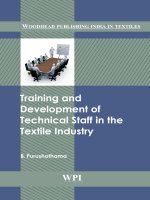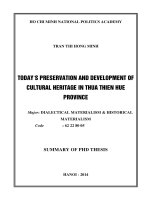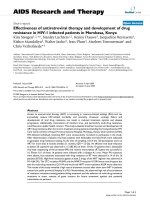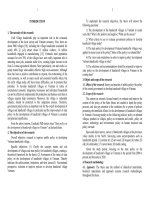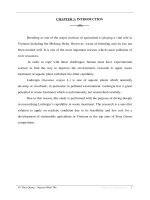RESEARCH AND DEVELOPMENT OF HYBRID RICE IN VIETNAM
Bạn đang xem bản rút gọn của tài liệu. Xem và tải ngay bản đầy đủ của tài liệu tại đây (3.3 MB, 63 trang )
RESEARCH AND DEVELOPMENT OF
HYBRID RICE IN VIETNAM
contraints and perpectives
*Nguyen Tri Hoan , Le Quoc Thanh
Vietnam Academy of Agricultural Sciences
* Pham Dong Quang
Minister Of Agriculture and Rural Development
*Ngo Van giao
Vietnam Seed Trade Association
*Duong thanh Tai
Southern Joint-stock Seed Company
Role of agriculture in Vietnam’s economy
Vietnam is predominantly an agricultural economy, based on
paddy rice production. Among the other edible crops, maize, sweet
potato, cassava, vegetables are most important. Rubber, coffee, tea,
coconut, sugarcane are the most important industrial plants
Vietnam is an agriculture-based country with more than 73% of
population depending on the agriculture
Rice is the most important crop with cultivated area is 7.27,6 million ha, maize 1.2 mil ha; Almost rice variety are inbred ones,
hybrid varieties accounting for around 700,000 ha.
Rice variety improvement is on the top of priority for rice research
during last two decades
Achivements in rice production in Vietnam during
20 years, from 1986 - 2005:
Average yield of rice increaced from 2.81 to 4.93 tons/ha
(1.7 times )
Total rice production increased from 16 to 36 million tons;
Rice export increased from 0.06 to 5.2 million tons
(2013 : Aver. yield 5,58 tons/ha, production 44 mill.tons,
exported 6.7 mil.tons)
Table 1: Area, Yield and production of rice in Vietnam
during 2001-2013
(Source :Statitical Department)
Year
2001
2002
2003
2004
2005
2006
2007
2008
2009
2010
2011
2012
2013
Area
Yield
Production
(1000 ha)
7,492.0.
7,504.3
7,452.1
7,329.2
7,329.2
7,324.8
7,207.4
7,400.2
7,440.1
6,990.5
7,651.4
7,761.3
7,900.7
(ton/ha)
4.29
4.59
4.64
4.86
4.89
4.89
4.99
5.23
5.23
5.72
5.53
5.64
5.58
(1000 tons)
32,108.4
34,447.2
34,568.8
36,148.9
35,832.9
35,849.5
35,942.7
38,729.8
38,895.5
39,988.9
42,324.9
43,737.6
44,053.0
Table 2 : Rice exported of Vietnam during 2001-2013
Year
2001
2002
2003
2004
2005
2006
2007
2008
2009
2010
2011
2012
2013
Rice exported
Quantity(mili. ton)
3.729
3.241
3.813
4.060
5.250
4.643
4.558
4.742
5.958
6.886
7.128
7.720
6.681
Value (mil.USD)
625
726
721
950
1.407
1.276
1.490
2.894
2.664
3.248
3.519
3.450
2.893
Price (USD)/ton
168
224
189
234
268
275
327
610
447
472
494
447
433
2. Investment, especially in irrigation system
3. Application of advanced technologies
New rice improved varieties:
- 149 varieties from 1986 to 2005
- 45,1% VN rice varieties were applied in the production
New advanced technologies widely applied: INM, IPM,
ICM, “3 giam 3 tang”, …
Hybrid rice: 600.000 - 700.000 ha/year
II.
PROGRESS IN HYBRID RICE
RESEARCH AND DEVELOPMENT IN
VIETNAM
1.Historical of hybrid rice development
-1980-1983 ; Rice breeders started to introduced and evaluated A and B
line from IRRI At CLRRI and VASI
-1992 Vietnam Introduced F1 seeds from China for testing and
demonstration in the farmers fields
- 1992-1995:
+Rice breeders introduced A Lines,B Lines from IRRI, China for hybrid
rice breeding in Vietnam.
+ Hybrid Rice Research Center belonged to VASI was established by
MARD.,
+ MARD gave subsidized fund for hybrid rice seed production and
hybrid rice commercial production.
+ FAO supported Vietnam TCP Project provided training rice breeding in
China, Provided International consultant on seed production and hybrid
rice breeding, provided some equipments for hybrid rice research.
-1996-2000 :
+:Second TCP Project supported by FAO for seed production and training at
IRRI and China
+ ADB/IRRI Hybrid rice Project supported for Parental lines purification and
Hybrid rice breeding
+Hybrid rice breeding and seed parent purification Funded by MARD. MARD
gave subsidized fund for hybrid rice seed production
-2001-2015 :
+ Hybrid rice Research project funding by MARD (80.000-10.000 USD pêr
year)
+Local hybrids ( 3 lines and 2 line hybrids) have been developed and released
for F1 seed production
+ 2000- 3000 ha of hybrid rice seed production have been done per year with
the yield of 2-2.5 tons/ha obtained
2, Status and trend of hybrid rice development
2.1, Progress of hybrid rice research
2.1.1,Exploitation of imported CMS lines and Developed new CMS
lines for breeding suitable 3 line hybrids
* IR 58025 A developed by IRRI
**Developed new CMS
Table 3 : Characteristics of newly developed CMS lines
CMS lines
IA/
BK7-8-2BC9
25A/
B8-3-1BC8
D62A/
R623BC
6
II32A/
OM250213BC11
BoA/
BK25BC8
BoA/
BK1-5-1BC9
74
71
65
75
71
67
70-75
75-80
70-75
76-80
50-55
75-80
8,9
11,4
10,2
10,2
10,8
10,3
3
2
5
5
5
3
76,3
87,6
75,2
81,6
62,4
73,5
98
90
98,8
98,5
90
97
Phenotype
Acceptability
(score)
1
1
1
1
3
1
Grain shape.
Round
Long
Long
Round
Long
Character
Duration to
heading 10 %
(day)
Stigma exert.(%)
Panical/hill
Off type (%)
Plant height(cm)
Sterile pollen (%)
Long
2.1.2, Results of developing new tropical
TGMS lines in Vietnam
The new TGMS lines had stable
pollen sterility under critical
temperature of 23-24oC, uniform
in phenotype combined with good
combining ability were developed
viz. AMS30S
(827S),T196S,103S,TGMS1
Some newly developed TGMS lines
have been used as female of
promising two line hybrids viz.
VL20, TH3-3, TH3-4, HC1, TH5-1,
HYT103, HYT102, VL24 HYT108,
LHD5 and LHD6.
2.1.3, Developed new TGMS based on adapted
maintainer line and restorer lines of 3 line hybrids
Aimed:
Overcome instability of some exiting CMS
Limited number of available CMS lines for 3 line
hybrid system.
Exploiting good flower characteristics, good
combining of exiting parental lines
Parental lines used :
4 TGMS lines were CL64S, 7S, CN26S, TG125S
Maintainer lines were II-32B, Jin 23B, IR62829B, BoB,
IR58025B, 97B,
Restorer lines were Gui99, Ce64, Fuhui838.
Table 4: Characteristics of newly developed
TGMS lines derived from exiting CMS lines
TGMS
lines
Duration
to
heading
(days)
AMS
35S-45
87
AMS
35S-46
87
AMS3
6S
AMS
37S-76
AMS
34S-10
85
72
72
Plant
Panicle/ Spikelet/
Stigma
height
Stigma exertion
panicle
color
hill
(cm)
65.3
7.4
194.0
Good
White
73.7
7.0
227.7
Good
Black
77.0
8.0
173.7
Very good
Black
Very good
Black
Very good
Black
63,3
67,7
6,6
8,5
197,3
156,0
2.1.4, Results of development for parental
lines having WC gene
The conventional high yielding varieties, adapted to
Vietnamese condition as Xi23, Q5, Chiem77, R242,
BM9855 etc… were used as male to cross with donor
having WC gene viz. Peiai 64S, N22, Palawan, Dular,
Calotoc, Lambayeque1, Moroberecan.
Single crosses were done and selection for parental lines
followed 2 directions:
(i) Select fertile plant in segregating generation
to male parent having WC gene
(ii) Selected sterile plants in segregating
generations of single crosses or in back crossing
generations.
Table 6 : Characteristics of newly developed TGMS
having WC gene (HRDC, 2005 - 2010)
D52S
D59S
Characters
D60S
sum
mer
spring
D116S
sum
mer
spring
sum
mer
spring
summer
spring
Day no. to flowering
82
62
86
64
82
62
86
64
Stigma exertion (%)
60
65
70
75
60
65
70
75
Pollen sterile (%)
100
100
100
100
100
100
100
100
Fertile pollen(%)
98
-
98
-
98
-
98
-
Tiller No./hill
9,0
14,0
9,5
15,0
9,0
14,0
9,5
15,0
Plant height (cm)
72,5
-
78,2
-
72,5
-
78,2
-
Selection of male lines containing WC
Along with observation and study in field,
leaves of the male lines were collected to analyse
AND by using PCR reaction with molecular marker
RM225, RM253, linked with WC gene which was
determined in the previous study.
Using 2 molecular markers RM225 and
RM253 to select lines which bring QTL/WC gene,
showed in figure 21, 22 following:
Combination two analyses result with two
marker RM225 and RM 253, we obtained 16
perpective male lines which absolutely contain
WC gene: D16-3, D27, D18-3, D22, D27-5,
D14, D25-2, D1-5, D17, D16-1, D16-6, D26,
D19, D52, D46 và D67.



